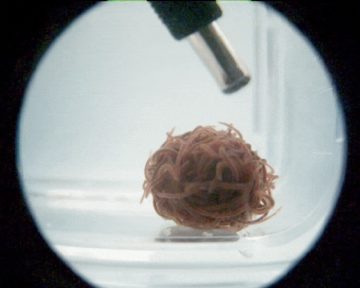Jack Tamisiea in Scientific American:
 Anyone who’s grappled with jumbled headphones knows the difficulty of disentangling snarled cords. A tight knot is nothing for a California blackworm, however. These tiny worms twist together by the thousands to form tightly packed blobs reminiscent of a forkful of squirming spaghetti. While these tangles take minutes to form, intertwined blackworms can wriggle free in a matter of milliseconds. Now scientists have finally straightened out how these legless escape artists use only a simple collection of muscles and neurons to seamlessly slither out of tight tangles. “We thought that if worms can solve this untangling problem, so could we,” says Vishal Patil, an applied mathematician at Stanford University. In a study published today in the journal Science, Patil and his colleagues used mathematical simulations to pinpoint the movements blackworms use to rapidly untangle themselves.
Anyone who’s grappled with jumbled headphones knows the difficulty of disentangling snarled cords. A tight knot is nothing for a California blackworm, however. These tiny worms twist together by the thousands to form tightly packed blobs reminiscent of a forkful of squirming spaghetti. While these tangles take minutes to form, intertwined blackworms can wriggle free in a matter of milliseconds. Now scientists have finally straightened out how these legless escape artists use only a simple collection of muscles and neurons to seamlessly slither out of tight tangles. “We thought that if worms can solve this untangling problem, so could we,” says Vishal Patil, an applied mathematician at Stanford University. In a study published today in the journal Science, Patil and his colleagues used mathematical simulations to pinpoint the movements blackworms use to rapidly untangle themselves.
At just a couple of centimeters long, California blackworms (Lumbriculus variegatus) are easy to overlook. Yet these aquatic worms, which are common grub for aquarium fish, exemplify strength in numbers. To conserve their moisture or maintain their temperature, anywhere from five to 50,000 blackworms intermingle to form writhing blobs seemingly right out of a creature feature. While these tangles are tight, the earliest sign of a predatory diving beetle will send the fleshy worms squirming in all directions.
More here.
